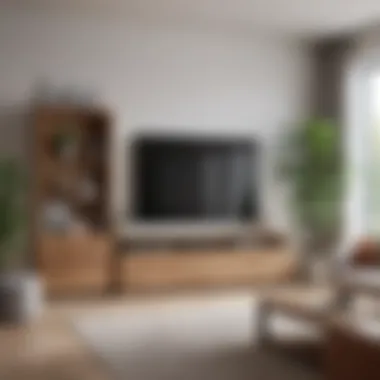Furniture with Built-in Storage: Transform Your Space


Intro
In the ever-evolving landscape of interior design, the function and form of furniture play a pivotal role. The integration of storage solutions into furniture is not just a trend; it reflects a lifestyle choice. Homeowners, especially those in urban settings, often face space constraints. In such environments, creativity in design becomes essential. The rise of furniture with built-in storage is a practical response to such demands.
This article will explore several dimensions of furniture with built-in storage. We will discuss how innovative designs contribute to the functionality of living spaces. The aesthetic appeal of these pieces will also be examined, shedding light on ways they break the monotony of traditional design. Moreover, we will touch on sustainable materials, providing insights into eco-friendly choices that enhance both organization and style.
Whether you are a homeowner looking to optimize space or an interior design enthusiast seeking inspiration, understanding the nuances of furniture with built-in storage is crucial in creating a cohesive living environment. The following sections will provide you with valuable insights that can transform your approach to interior design.
Prolusion to Built-in Storage Furniture
As interior design evolves, the significance of furniture with built-in storage becomes increasingly evident. This concept is not merely an aesthetic choice; it serves functional needs that resonate with modern living. Homeowners often find themselves juggling between space, organization, and style. Therefore, integrating built-in storage solutions can be an effective strategy to tackle these challenges.
Defining Built-in Storage
Built-in storage refers to furniture designed to incorporate compartments for storage within its structure. This can include couches with hidden compartments, beds with drawers beneath, or bookshelves combining display space with concealed storage.
Unlike traditional furniture, built-in storage optimizes space efficiently. In smaller homes or apartments, where every square foot counts, built-in options can greatly increase functionality. They allow homeowners to maintain a clean look while keeping clutter at bay.
The Relevance in Modern Interiors
In contemporary interiors, functionality often outweighs form. However, this does not mean that aesthetic is disregarded. Built-in storage marries these two aspects seamlessly. With the increasing trend of minimalism and multifunctional spaces, the relevance of built-in storage cannot be overstated.
- Space Efficiency: By utilizing existing architectural elements, built-in options utilize space in a way that freestanding furniture does not.
- Flexibility: These pieces can be tailored to fit various room dimensions and design motifs.
- Enhanced Organization: Built-in furniture often encourages better organization, vital for modern living where disarray can create stress.
"Investing in furniture with built-in storage is not just an interior design choice; it is a smart lifestyle decision."
In summary, built-in storage furniture is an invaluable asset for anyone looking to streamline their home. It highlights a proactive approach to achieving a balanced environment that caters to both aesthetics and practicality.
Types of Furniture with Built-in Storage
Furniture with built-in storage enhances functionality in our living spaces while presenting an opportunity for creative design. With careful choice, these pieces serve dual purposes. They make available more living space by reducing clutter. Furthermore, they provide stylish solutions tailored to modern needs. This section delves into various types of furniture equipped with storage, highlighting their benefits and considerations.
Sofas and Sectionals
Sofas with built-in storage are becoming increasingly popular. They often feature compartments beneath the seating area. These compartments can hold blankets, pillows, or even books. One notable advantage is that they maintain the living room's aesthetic appeal without sacrificing utility. A sleek sectional equipped with hidden storage can meet the needs of family gatherings effortlessly. Think of how often one seeks extra seating while also needing a place to stash remotes or magazines.
Storage Beds
Storage beds represent another smart solution, especially in smaller bedrooms. They come with drawers built into the base of the bed or have lift mechanisms to access spacious areas underneath. This design is optimal for storing off-season clothing or extra bedding. Choosing a storage bed that complements your bedroom's decor is important, as it can instantly elevate the room’s overall style. In fact, versatile frames in both minimalist and ornate designs are available, ensuring that functionality does not compromise elegance.
Coffee Tables with Storage
Coffee tables that include storage elements can transform a living room. For example, some come with side drawers or a lift-top. This allows for concealed storage for coasters, snacks, or even board games. They help keep the coffee table area tidy. They also provide a balanced mix of practical use and style. Customers should opt for materials that harmonize with existing decor to enhance visual integration.
Ottomans and Poufs
Ottomans and poufs are versatile by design. Many ottomans feature hollow sections that offer additional storage. They can be used as footrests or extra seating as well. Poufs are often lighter and can easily be moved. Both items can store a variety of items from toys to blankets. These pieces easily complement other furniture, making them functional additions that contribute to both style and organization.
Bookshelves and Media Units


Bookshelves with built-in storage can go beyond mere display. They provide a home for books, but also can include cabinets or drawers below. This additional storage space is ideal for games, media, or decorative items, making organizing efficient. Media units typically cater to technology needs, housing electronics and keeping cables hidden. They also offer storage for DVDs and video games, merging technology with style seamlessly. Readers should consider the room’s layout when choosing sizes and shapes to ensure functionality meets design seamlessly.
Benefits of Built-in Storage Solutions
Furniture with built-in storage is not just about aesthetics; it offers numerous benefits that enhance functionality in any living space. Understanding these benefits can help homeowners and interior design enthusiasts make informed choices. The integration of storage solutions into furniture designs allows for both space efficiency and organization, key factors in modern living.
Maximizing Space Utilization
One of the most significant advantages of built-in storage is the ability to maximize space utilization. Many homes, particularly in urban areas, face challenges related to limited square footage. Built-in storage furniture, such as storage beds or sofas with compartments, provides practical solutions to these problems.
- Custom Fit: Built-in options can be tailored to fit specific rooms, ensuring that every inch of space is utilized.
- Multi-Functional: Items like ottomans and coffee tables serve dual purposes, acting as both seating or surfaces while offering hidden storage.
- Clutter Reduction: With designated spaces for items, it becomes simpler to keep areas tidy and organized, improving the overall visual appeal of the home.
Enhancing Aesthetic Appeal
Built-in storage solutions also enhance the aesthetic quality of a home. These furnishings can beautifully blend with existing decor while providing necessary storage.
- Seamless Integration: They can be designed to complement existing architecture, making them look like a natural part of the room.
- Stylish Designs: Modern built-in options come in various styles, from minimalist designs to more traditional cabinetry, allowing homeowners to choose what best fits their taste.
- Color and Finish: Custom colors and finishes offer the chance to create cohesive interior design and personalize space.
Improving Organization
The organization is a central theme in any well-designed living space, and built-in storage significantly contributes to this aspect. They allow for systematic arrangement of belongings, reducing chaos and enhancing productivity.
- Defined Spaces: Different compartments can be designated for specific items, leading to easy access and retrieval.
- Visual Clarity: By keeping things stored neatly away, surfaces remain clean, contributing to a more calming environment.
- Easier Maintenance: Organized spaces require less time to maintain, as finding items becomes quicker and more intuitive.
Sustainable Living Options
An increasing concern among modern homeowners is sustainability. Integrating built-in storage can provide eco-friendly solutions that promote sustainable living.
- Quality Materials: Many manufacturers now focus on sustainable materials like reclaimed wood or eco-friendly finishes, reducing their environmental impact.
- Longevity: Built-in furniture tends to be more durable than traditional furniture, decreasing the need for replacements and, therefore, waste over time.
- Efficient Space Usage: By maximizing the use of available space, there's less need for excessive furnishings, further supporting sustainable practices.
The thoughtful design of built-in storage solutions showcases how functionality and sustainability can harmonize in modern interior design.
Choosing the Right Built-in Storage Furniture
Selecting the right built-in storage furniture is crucial for creating spaces that are both functional and aesthetically pleasing. The integration of storage solutions into your home can transform the way you use and experience your living areas. Furniture with built-in storage not only helps reduce clutter but also maximizes space in a thoughtful manner. When making your choices, it is essential to consider various factors that align with your personal requirements and design preferences. Each aspect—from assessing your needs to evaluating the materials—plays a significant role in ensuring that your investment is practical and suitable for your home.
Assessing Your Needs
Begin the selection process by carefully assessing your storage requirements. Consider the types of items you intend to store and how often they will be accessed. For instance, if you need extra space for seasonal clothing or linens, a storage bed may be ideal. On the other hand, if you often entertain guests, a sofa with hidden compartments can serve dual functions effectively.
Think about the layout of your rooms. For example, a small living room may benefit from a coffee table with storage capabilities, offering a place to store magazines or remote controls. Create a list of items you want to store and their respective dimensions to have clarity moving forward. Failing to assess your needs accurately can lead to purchasing inadequate furniture that does not address your storage problems.
Evaluating Design and Style
Design and style are equally vital when choosing built-in storage furniture. It is important that the pieces complement the existing decor and enhance the overall appearance of the room. From sleek modern designs to more traditional styles, a range of options is available to suit various aesthetics.
Consider how the new furniture will fit into your environment. A sectional sofa with storage, for instance, should not only match your style but also coordinate with the color schemes and texture of your rooms. Think about how the piece will interact with natural light and other furniture in your space. Additionally, ensure that the design does not impede movement or flow throughout the room, maintaining an inviting atmosphere.
Material Considerations


Materials play a pivotal role in both the durability and appearance of built-in storage furniture. Different materials will offer different advantages and disadvantages. For example, solid wood is often praised for its durability and classic appeal but can be heavier and more expensive than other options.
On the other hand, materials like engineered wood provide a cost-effective alternative while also being available in a variety of finishes. Metals and glass can introduce modernity and lightness, but might not always suit a warmer decor style. Assess the materials based on your lifestyle; for example, if you have children or pets, opt for sturdy and easy-to-clean materials.
Additionally, sustainability is becoming a critical factor in material selection. Consider sourcing furniture made from recycled or sustainably harvested resources. This choice contributes to environmental health and sometimes enhances product quality. Evaluate the maintenance needs of each material as well; some materials may require more up-keep than others.
In summary, choosing the right built-in storage furniture involves a deep understanding of your needs, the importance of design and style, and careful selection of materials, which will all contribute to an efficient and visually appealing living space.
Integrating Built-in Storage into Different Rooms
Integrating furniture with built-in storage into various rooms is vital for optimizing space and improving organization. Such integration allows for a cohesive design that prioritizes both aesthetics and functionality. Every room in a home serves a specific purpose, and utilizing storage solutions tailored to those purposes can significantly enhance the overall atmosphere.
Incorporating built-in storage reduces clutter, making living spaces more inviting. This approach not only saves floor space but can also reflect the owner's style. Thoughtfully designed storage elements can seamlessly blend with the rest of the interior, creating a harmonious environment.
Living Room Solutions
In the living room, multifunctional furniture is key. Consider sofas with built-in compartments or coffee tables with hidden storage. These pieces serve dual purposes, providing a comfortable seating area while also offering space for items like blankets, books, or remote controls. A well-designed entertainment unit can also conceal cables and game consoles, giving the room a cleaner appearance.
- Maximizing seating: Invest in sectional sofas that include storage underneath.
- Smart coffee tables: Opt for designs that provide shelves or drawers.
- Wall-mounted shelves: These can free up floor space while displaying decor.
Bedroom Innovations
In the bedroom, storage needs often revolve around clothing, linens, and personal items. Storage beds have gained popularity for their ability to provide significant space without compromising on style. They can minimize the need for additional furniture and help keep the room decluttered.
Additionally, bedside tables with drawers can make small items easily accessible but out of sight when not in use.
- Under-bed storage: Use boxes or built-in drawers to utilize the space efficiently.
- Mirrored wardrobes with storage: These can reflect light and create an illusion of space.
- Floating shelves: Perfect for storing books or decorative items without taking up floor space.
Kitchen and Dining Enhancements
Kitchens benefit greatly from built-in storage solutions that enhance functionality. Cabinets designed to maximize vertical space can keep countertops clear, promoting better organization while cooking. Lazy Susans or pull-out drawers within cabinets make accessing pots, pans, or utensils easier.
When it comes to dining areas, sideboards or buffets can provide additional storage for dining essentials without looking cluttered. This is perfect for storing tableware, extra linens, and other dining accessories.
- Pantry pull-outs: Optimize space for food storage.
- Built-in benches with storage: These serve as seating for dining while hiding items like pillows or blankets.
- Compact dish racks: These enhance drying areas without taking up valuable counter space.
Home Office Efficiency
As more individuals work from home, integrating built-in storage solutions into home offices has become increasingly relevant. A well-organized workspace enhances productivity, and custom desks with drawers can help maintain a clean and efficient working environment.
Incorporating shelving above desks can also maximize vertical space while displaying books or decorative items related to work. File cabinets can be discreetly tucked within units to keep documents organized but out of sight.
- Corner desks with shelving: These utilize awkward spaces effectively.
- Cable management systems: These help keep electronic devices organized.
- Multi-functional workstations: Look for designs that include a fold-out table for meetings or extra workspace.
Built-in storage not only optimizes space but brings a level of sophistication that reflects personal style.
DIY Built-in Storage Solutions
Building your own storage solutions can be an incredibly rewarding aspect of interior design. DIY built-in storage allows homeowners to tailor furniture to fit specific needs, particularly in spaces that require a careful balance of functionality and aesthetics. This section focuses on the importance of adopting a DIY approach, highlighting its versatility and creativity.


Planning Your Project
When considering a DIY project, planning is vital. Start by assessing the area where you wish to add built-in storage. Measure the dimensions carefully. Consider the amount of storage you require and how you intend to use this space. Are you storing books, toys, or perhaps kitchen items? Identify the main goals. Sketching a rough design can facilitate a clearer vision. Be realistic about your skills and tools; the scope of the project should match your abilities to avoid frustration. Remember that mistakes in the planning stage can lead to costly adjustments later on.
Material Sourcing
The right materials can make a huge difference in the success of your project. Local hardware stores often carry various options, from plywood to high-quality veneer. Consider sustainable materials if you are conscious of environmental impact, such as recycled wood or bamboo. Online platforms can also provide diverse choices, including specialty finishes. Ensure you gather all necessary supplies beforehand to avoid interruptions during construction. A list can be helpful:
- Wood panels
- Screws and fasteners
- Paint or stain
- Tools such as saws and drills
- Safety gear like goggles and gloves
Construction Basics
Once you have planned and sourced materials, it's time to build. Adhere to your design closely. Start with the frame; it should be solid and square to support the weight of items you will store. Measure twice to ensure accuracy, and cut once. Assemble the pieces carefully; using clamps might help keep everything in place while you secure joints. After the framework is complete, install shelves as needed. Finishing touches like paint or varnish give your project a polished look. Don’t rush this step, as a good finish can elevate the overall design significantly.
"DIY storage solutions are not just practical but can also become a statement piece in your home."
Challenges with Built-in Storage Furniture
Furniture with built-in storage offers many benefits, but it also comes with its unique set of challenges. Understanding these challenges is important for homeowners, interior design enthusiasts, and anyone considering such furniture. Addressing issues related to design limitations, costs, and maintenance ensures that built-in storage can truly serve its intended purpose without becoming a burden.
Design Limitations
One of the primary challenges with built-in storage furniture is design limitations. These solutions are often tailored to specific spaces, meaning they can restrict flexibility in terms of arrangement and function. For instance, a storage bed might fit perfectly in one bedroom, offering ample space for linens and other items, but may not be as effective in a different room layout.
Additionally, custom designs may limit options for future changes. When interior styles evolve, or personal preferences shift, replacing or modifying built-in pieces can be difficult. Any change might necessitate extensive renovations. Therefore, its essential to consider how the chosen design will integrate long-term into the overall home aesthetic.
“Designing for now is fine, but it is wise to think about the future. A balance must be struck between functionality and flexibility.”
Cost Considerations
Cost is another significant factor when selecting built-in storage furniture. Initial pricing often appears higher compared to traditional storage solutions. Premium materials and design complexity can contribute to this escalation. For example, custom-built cabinetry can require a substantial investment upfront. Homeowners should take into account not just the purchase cost but also potential installation charges and future modifications if necessary.
Despite these costs, built-in storage can provide savings in the long run by enhancing space efficiency. Evaluating potential return on investment is essential, especially in areas like kitchens and bathrooms, where well-designed storage can increase property value.
Maintenance and Accessibility
Maintenance considerations also play a critical role in the feasibility of built-in storage solutions. Depending on the materials and designs, some installations may require more upkeep than others. For example, wooden structures might need regular polishing or treatment to prevent wear, while metal components could be prone to rust if exposed to moisture.
Accessibility is another aspect that should not be overlooked. Built-in storage is often designed with the style of the room in mind, which can sometimes lead to hard-to-reach spaces. Items stored high up or in difficult configurations may require additional effort to access. As people age or their physical abilities change, this accessibility could become an impediment.
Finale: The Future of Built-in Storage Furniture
The relevance of built-in storage furniture has become increasingly apparent in modern interior design. As homeowners seek to maximize their living spaces without compromising on style, innovative storage solutions continue to emerge. This conclusion synthesizes key points discussed in the article and emphasizes both the current trends and future outlook of built-in storage solutions.
Trends to Watch
The future of built-in storage furniture revolves around several key trends, which include:
- Sustainable Materials: More consumers are opting for eco-friendly materials. Furniture manufacturers are responding by using recycled or sustainably sourced materials in their designs.
- Modular Furniture: Flexibility is crucial in contemporary homes. Modular designs allow users to reconfigure their spaces as needed, offering adaptability and personalization.
- Smart Technology: Integration of technology with furniture is on the rise. Built-in charging stations, LED lighting, and automated mechanisms are becoming common in storage solutions, enhancing user experience.
- Multi-functional Designs: The demand for versatility is increasing. Furniture designs that serve multiple purposes, such as storage beds or ottomans with compartments, are gaining popularity due to their efficient use of space.
By paying attention to these trends, one can make informed decisions when selecting furniture that serves dual purposes of storage and decoration.
Final Thoughts
The integration of built-in storage in homes is no longer just a trend; it has become a necessity. As we look forward, the focus will be on balancing functionality with aesthetics, ensuring that storage solutions enhance both the livability and design of spaces.















